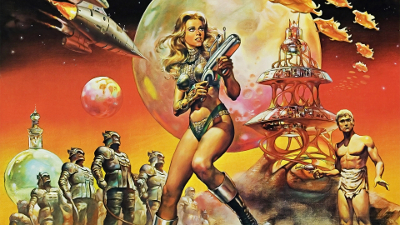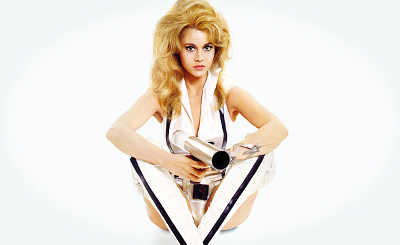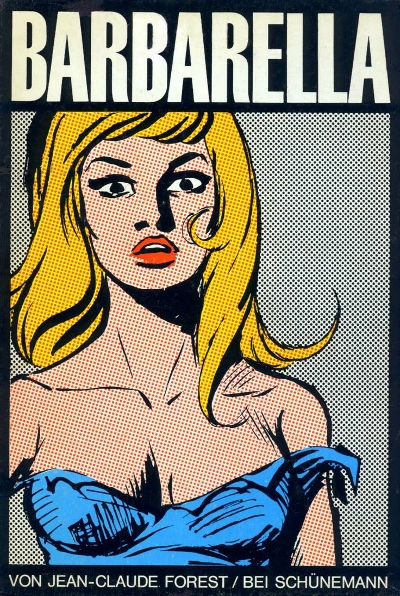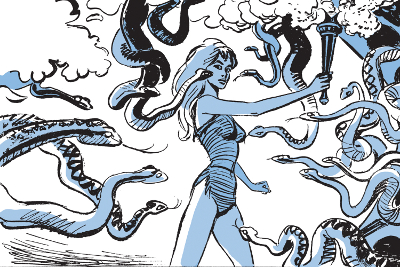|
Barbarella - Jane Bond?

"The
fictional character that Barbarella can most closely be said to
resemble is actually Ian Fleming’s James Bond... like Bond, Barbarella
is constantly jumping from one self-contained (sort-of) adventure to
the next. She’s in a constant state of arousal, and like Bond, she uses
her charm to bed whomever she finds the most attractive — friend and
foe alike."
- Shea Hennum - thisisinfamous.com
Barbarella is a campy cult 1968
science fiction film directed by Roger Vadim and based on the French
comic strip created by Jean-Claude Forest for V magazine in 1962 about
the colourful adventures of a scantily clad female astronaut.
Barbarella (Jane Fonda) is a celebrated "astronavigatrix" in the year
40,000 AD - a time when war no longer exists and peace reigns
throughout the universe. Our heroine is swiftly contacted by the
President of the Republic of Earth (Claude Dauphin) to undertake an
important and dangerous mission. Barbarella is ordered to search for
mad missing scientist Durand Durand (Milo O'Shea) in an unknown region
of space - Durand Durand having been abducted and taken to Tau Ceti
while on his way to the North Star and in possession of a secret
doomsday weapon known as the Positronic Ray.
After crash-landing during a
magnetic storm on the rather strange planet of Lythion in her very
sixties hippy spaceship known as Alpha 7, Barbarella is thrown into a
series of baroque adventures involving carnivorous dolls, a blind
angel, a sexual pleasure machine, sadistic children and much more
besides...
There isn't a tremendously huge
amount of plot to convey in any review of Barbarella which is - let's
be honest - a cult film principally because of the wide-eyed and
appealing presence of a young Jane Fonda in very few clothes rather
than any great direction on the part of Roger Vadim or a terribly witty
script. Just the opening title sequence alone would probably ensure
Barbarella some sort of immortality in the annuals of cinematic
history, strange or otherwise. To the strains of the fantastic
psychedelic sixties pop score, Jane Fonda performs a zero gravity
striptease as she dispenses with her spacesuit (with strategically
placed funky credits) in the confines of her very strange spaceship -
which is rather luxuriously carpeted and looks like the inside of Jason
King's bachelor pad. It's an instantly iconic and visually arresting
bubble strewn opening to the film.
Fonda's mixture of eroticism and
general bewilderment at her surroundings is the film's biggest strength
although the actress apparently later lamented the fact that she turned
down Roman Polanksi's Rosemary's Baby to mooch around in France and
shoot the insanely kitsch Barbarella - which is fair enough as
Rosemary's Baby was obviously a much better film.
Barbarella is more of a far out
experience than a coherent picture of any great description and you
frequently find that you have only a vague idea as to what exactly is
happening or what the characters are all going on about. As soon as
Barbarella crash-lands on the icy alien planet she is - in a bizarre
scene - attacked by children with snowballs ("Listen you kids, untie me
or I'll call your parents!") and little dolls with metal teeth. Around
this point you get the first inkling of two constants in the film. (1)
Jane Fonda's extensive range of space vixen outfits tear remarkably
easily and (2) she has relations with practically every single
character she meets.
This is a new experience for
Barbarella as this is now an artificially induced pastime on Earth - an
idea that Woody Allen might have borrowed for his 1973 classic sci-fi
comedy Sleeper. Although this all sounds rather risque, the film is
fairly tame to modern eyes and Fonda essentially plays Barbarella as an
innocent - albeit one with a shag carpet spaceship, a plexiglass bed,
thigh high boots and a wardrobe that would make Katie Price blush.

Despite the fact this is
supposed to be the year 40,000 AD, Barbarella is a hippy flower power
child of the sixties and therefore open to new experiences and doesn't
rush to judge people. She even has to learn how to use weapons from
Earth's Museum Of Conflict and seems bewildered that the tranquil
nature of the universe could ever be threatened when thrown into action
by the President at the beginning of the film. Babs is truly shocked
that anyone, anywhere "Could still be living in a primitive state of
neurotic irresponsibility." As her mission progresses, Barbarella meets
Pygar (John Phillip Law), a blind angel who is trapped in the city of
Sogo because he can't fly anymore. "An angel does not make love," says
Pygar. "An angel IS love."
Law spends the film in a
loincloth and a pair of fake wings and has to suffer the faint
indignity of some rather dated flying sequences. The villain of the
piece is The Great Tyrant, played by Anita Pallenberg in a range of
leather outfits just as skimpy as Fonda's wardrobe and David Hemmings
also pops up in a comic role as Dildano, the leader of the rebel forces
that oppose The Great Tyrant. "Are you typical of Earth women?" asks
Didano. "I'm about average," replies Barbarella. Pallenberg camps it up
as best she can with some eccentric dialogue thrown in her direction by
the numerous screenwriters. "Then you're a dead duck - Guards! To the
Mathmos with this winged fruitcake!"
Barbarella is frequently cited
as one of the campest and cheesiest films ever made and it doesn't
disappoint in this regard. The film is well aware of its high camp
mature cheese factor and wallows in it with colourful sets that look
like something stolen from Star Trek and spray painted by people on
hallucinogenic substances. One can see the legacy of Barbarella in
later camp sci-fi epics like Mike Hodges' 1980 version of Flash Gordon.
The production design is alarmingly weird and knowingly staged to have
a comic book sheen. Sometimes it all looks shoddy and dated but there
is a vague sense of wonder created at times with the completely bonkers
costumes and bright backdrops.
The visual effects are more
variable and haven't really stood the test of time. Although the film
is meant to be a comedy and takes itself about as seriously as a Carry
On film, there is generally a distinct lack of wit in the script that
is a slight disappointment on the whole. "This is a much too poetic way
to die," says Barbarella in one of the better lines while being
attacked by budgies or something. The film could have done with much
more of this.
Barbarella is colourful nonsense
but nothing awfully special in terms of its direction or screenplay.
Roger Vadim seems content to merely point the camera at his spangly
costumed cast and elaborate sets and wasn't exactly Stanley Kubrick on
this evidence. It's a so-so sci-fi parody that relies heavily on Jane
Fonda for its cult status and appeal - the actress the main reason to
watch the film, frequently looking baffled but amazing in her retro
futuristic surroundings and spare silver foil outfits.

"For days on end her rocket
raced past airless, lifeless worlds..." The kitsch psychedelic and
cheeky French comic strip created by Jean-Claude Forest in 1962 was
collected together into a single volume a few years later and became a
huge cult hit. If anything the comic is even more bonkers than the film
it inspired. If Barbarella ended up running a space circus (and she
does) you wouldn't be surprised. Our doe eyed heroine's main task here
is (again) trying to rescue the scientist Durand Durand from the
clutches of the evil Black Queen on the planet Lythion. "Barbarella
recognized Lythion by its three satellites. The galactic charts showed
it as being a relatively hospitable planet. Beneath the spaceship, a
continent unfolded, which at first appeared to the traveler to be
nothing but a volcanic desert. Suddenly, nestled in a giant crater,
Crystallia, the great greenhouse, appeared..."
Once on this hippy trippy
bizarre planet, Barbarella becomes mixed up in a conflict between the
Crystallians, who live in a giant greenhouse, and the barbaric Orhomrs,
who live in the frozen wastes. I think I'd rather live in a greenhouse.
The story grows increasingly eccentric with the introduction of Pygar
the Blind Angel ("the last of the ornithanthropes") and the "icy region
of Yesteryear" - patterned on 19th century Earth. Anything is possible
in the world of Barbarella.
This was considered to be an
adult comic in its day but it feels tamer now with the passage of time
- especially if you've read many modern graphic novels. It is though
far more shameless than the film it inspired. The filmmakers clearly
had to tone Barbarella down to get it onto the screen. At the time the
comic was banned from public display when it was condensed into a
single volume but it became very popular and was widely praised. The
tabula rasa Barbarella, a mixture of eroticism, vulnerability, and
invincibility was a hugely successful character and a genuine French
comic book icon. No small part of the appeal was the fact that Forest
deliberately drew Barbarella to look like Brigitte Bardot.
The style of Barbarella is free
form, improvised. In other words, Forest was making it up as he went
along. He wanted no constraints whatsoever on where his imagination
would take him or Barbarella in this strange futuristic (and sometimes
anachronistic) universe. A very obvious inspiration here is Alice in
Wonderland with the anything goes twists and vignettes. One of the
author's more striking flights of fancy has a group of pirates based in
a jellyfish. That's a bit impractical I think (!) but pirates in
jellyfish are par for the course in Barbarella. You also get nasty
children who set carnivorous dolls on you and "air sharks" (an idea
that Dr Who might have pilfered) who worm their way up through the
labrythrines to eat you.
This is all why the famous film
version of Barbarella never struck a bullyseye in the end despite
capturing some of the look and essence of the comic. No one has ever
looked so good in bacofoil and plastic as Jane Fonda (wonder if they
asked Bardot to play the part?) but the more extravagant and outlandish
gambits of the comic strip were always going to be mission impossible
for the filmmakers. When Pygar the Blind Angel flies through the air
with Barbarella in the comic amidst puffy white clouds the effect is
almost poetic. In the film it just looked silly. Comics are always
going to be greater than the films they spawn. Comics can do anything
they want without worrying about special effects or people looking
silly.
Barbarella is a strange comic
(don't look for the story to ever make much sense) but an interesting
one and very much a product of the sixties. I think the episodic nature
of the book - it is a collection of comic strips - might possibly
frustrate those looking for a narrative but the randomness and offbeat
nature of Barbarella is a strength as much as a weakness. One thing
that is noticeable here is how the comic strip Barbarella is tougher
and feistier than the Jane Fonda incarnation. Not quite so much of a
baffled innocent bewildered by everything around her.

Barbarella is often in a state
of undress and has relations, with just about everyone she meets -
including robots. "Madame is too kind. There's something a bit
mechanical about my movements!" But the strips (no pun intended) are
also rather quaint and charming at times. I don't know when something
slides over from cheeky into vulgar but Forest flirts with this
distinction. Forest regarded Barbarella to be a symbol of growing
female liberation and the comic was maybe ahead of its time. It was
translated into dozens of languages and drew huge critical praise.
One thing that is really clever
about the comic is the way that Forest draws inspiration from vintage
strips like Flash Gordon. Barbarella sometimes evokes the rocky, red
hued landscapes and atmosphere of that famous serial. A very simple art
style is deployed with minimal use of colour but the effect is often
striking. There is some experimentation too which I find interesting.
Forest is not one of those artists where all of his illustrations look
exactly the same. He can do big, bold comic book and he can do
minimalist. He manages to get interesting effects here from deceptively
simple looking panels and backdrops that you often dwell on to enjoy
and take in.
Barbarella reminded me very much
of Alan Moore's The Ballad of Halo Jones so presumably that book was
inspired in some way by Forest. Like Halo, Barbarella has a story arc
that continues over three sections and finds her in somewhat different
circumstances in each one. The art is of a similar style too. The
essential difference is that Halo Jones is an ordinary woman to whom
extraordinary things happen. You couldn't really describe Barbarella as
an ordinary woman. This is a very far out and sixties comic and often
great fun. It has a decent sense of humour and is always imaginative
with inventive and effective art. It is certainly worth getting hold of
if you are a fan of vintage comics.
c 2016
Alternative 007
|

|


